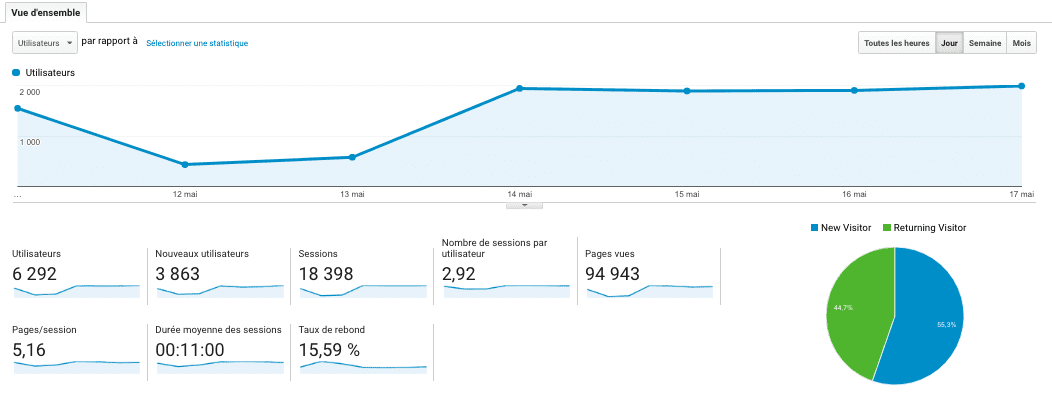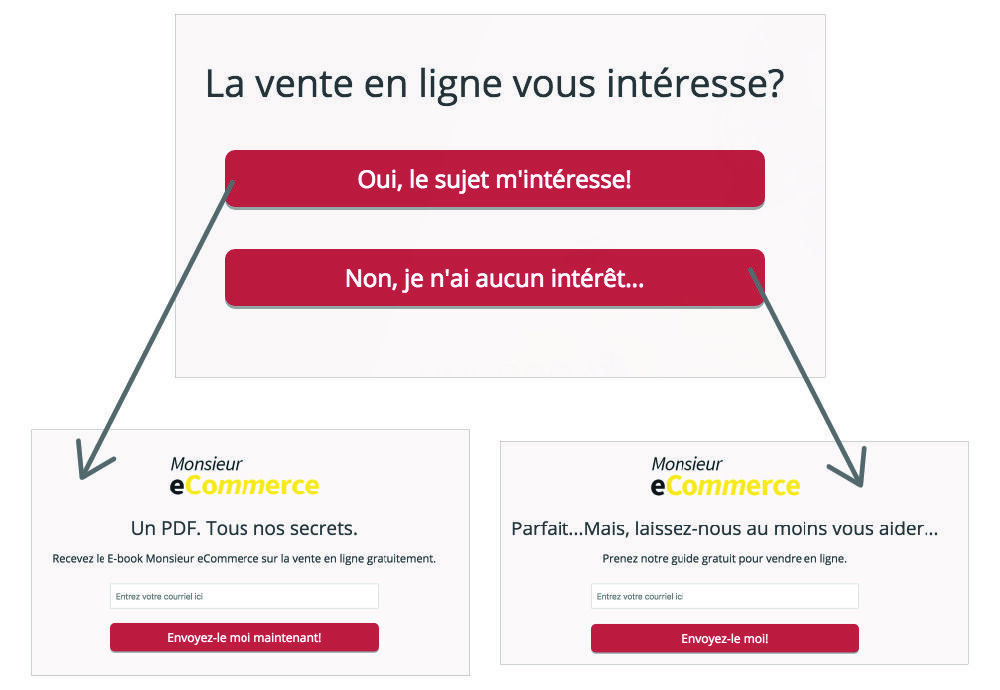Curious to know how to scale your Facebook Ads over $1,000/day? Get our experts' recommendations for free! All our clients went through this step!
Increasing Your E-commerce Sales - David Grégoire’s Tip & Tricks
Increasing Your E-commerce Sales - David Grégoire’s Tip & Tricks
We welcomed David Grégoire, alias "Mr.E-commerce," during our 5@J7. Seeing as e-commerce is an industry that is not running out of steam any time soon (and because as an agency we are in permanent contact with it), David passed by to share his expert advice to help you increase your e-commerce sales.
We welcomed David Grégoire aka "Mister E-commerce" at our 5@J7. E-commerce is an industry that’s not losing steam (and, as an agency, we’re in constant contact with it), so David came to share some advice to help you increase your e-commerce sales.
INVENT, TEST, VALIDATE, INCREASE
One is not born Mister E-commerce; you become it by inventing, testing, validating and increasing sales techniques.
That’s the training that David received while working at Voyage à Rabais, an e-commerce website that generates over $100 million in sales per year.
Starting on Google Adwords, he had carte blanche to boost the agency's sales. That's how he was able to try new things, both in terms of online advertising and on the website itself. A Growth Hacker philosophy, basically.
Then came a day when David made the decision to leave Voyage à Rabais to start his own business.
Since then, he has created several businesses, while others have fallen into oblivion…
"I had an online funeral store that didn't work at all! Maybe too early for the times..."
Finding The A-ha Moment
In entrepreneurship, there is a well-known term called A-HA. It’s mentioned in books such as:
- Zig-Zag : The surprising path to greater creativity by Keith Sawyer
- Hacking Growth by Sean Ellis
It refers to the moment when we understand why something works and when we become aware of its potential.
To give you an example, Instagram was not launched on the mobile application market as is.
It was previously called Burbn (for Bourbon Whisky).
Burbn was designed as a geolocation app to discover new places and to share photos at these locations.
A Massive Failure Until The Creators Had An A-ha Moment…
Everyone used Burbn in the same way and only one feature was popular on the app... I'll let you guess which one.
After that A-HA Moment, Burbn became Instagram and its design was revisited to allow photo sharing in less than 3 clicks.
Let's go back to David, who had his AHA Moment by dint of calling online merchants to offer them his services.
By always asking the same questions, he made an interesting discovery: 80% of online merchants did not display 100% of their products on their websites.

A-HA!
If the majority of e-commerce businesses do not put 100% of their items online, it must be because it’s a difficult task.
If it’s difficult, there’s a market.
From that point on, David launched two things:
- Monsieurecommerce.com: A business that helps you manage your products and put them online.
- Snapshop: an app that allows you to take pictures of your products (in your kitchen, for example) and then transform them into ready-to-use images (no background, without any decor).
Snapshop reached a record of more than 1,200 photos taken with the app in a single day!
SO, WHAT ARE THE KEY TAKEAWAYS?
Don't fret! I'm getting to the serious stuff...
What’s our advice for your e-commerce business?

A - THE WEBSITE
SEO (organic traffic) is a must and an essential element to improve your visibility on the Internet. If you’re not doing any SEO, you’re playing against Google, Yahoo and all the other search engines in the world.
Of course, we’re not SEO experts, so you’ll need to find other ways to make sure that you’re respecting the rules imposed by search engines.
David is a big Shopify user, and the platform offers you (when you create an e-commerce website) paid templates with basic built-in SEO. Use one, you'll save time.
Then, make sure that you never duplicate pages (and their content) on your website. Google hates that.
Finally, make sure you have SEO-friendly URLs. That is, your pages should have short, simple and unique URLs.
Tracking is also an essential part of e-commerce and you shouldn't get started without it.

David and I share the same fear of offline advertising.
Let's say you advertise your store in a local newspaper.
On the weekend after its publication, your store is a little bit busier than usual.
So you wonder:
- How many people have seen my ad?
- Is it a coincidence that I have more people visiting the store?
- How much did this ad actually bring in?
So many unanswered questions, because it’s impossible to interrogate all the visitors and newspaper readers.
E-commerce and online advertising are different.
Sales, clicks, adds to cart, shopping cart abandonments, page views... Everything is traceable.
But don't wait! This is something that I mentioned in a previous article; you need to set up Google Analytics (e-commerce tracking) and Facebook pixels as soon as you start your business.
"The best time to plant a tree was 20 years ago."
You may not be ready to use it right away, but the day will come when you finally need it and you won't have any data...because setting up your pixel has no retroactive effect. You won't get data from past visits.
The Pop-pup, Another Mandatory Element.
Yes, we know, pop-ups are annoying and not very pleasant, but they’re devilishly effective.
David came up with some interesting data on this.
Let's imagine that your conversion rate (i.e. the number of purchases compared to the number of visits per month) is 1%.
You set up a pop-up and get the email addresses of 10% of your website visitors.
Then, with an email sequence, you manage to sell to 10% of these people.
Congratulations, you just reached a 2% conversion rate (I did the math, I promise it works).
Just one small piece of advice though; trigger the pop-up for about ten seconds after login, not before.

B - Promotions
When you offer a promotion to your visitor, you have two options:
- Offer a discount in dollars: -$15 on your bill
- Offer a percentage discount: -20% on your bill
Without hesitation, David recommends choosing the larger of the two numbers.
Although the 20% does not necessarily offer the biggest discount depending on the amount of your bill, psychologically, it’s bigger than $15.
Then, shopping cart abandonment... a scourge that affects us all (we're talking about 70% of buyers in the industry).
Without necessarily running retargeting ads (targeting specific people), you can use email marketing.
You’ve surely noticed that, before finalizing an online purchase, your email address is always the first piece of information that you have to give. That’s so we can send you follow-up emails with the contents of your shopping cart, of course.
David gives you two options:
- Send an aggressive follow-up with a promotion (bad investment, but good returns).
- Ask questions (good investment, but poor returns).
When you're starting out and you're faced with your first shopping cart abandonments, you'd be tempted to want to get the sale at all costs. The problem is that you’ll never know why the person did not complete their purchase in the first place.
Is it because of the shipping charges? The terms and conditions of sale? Was it simply not an appropriate time to be inputting a credit card number (e.g. on the bus)? You'll never know and, therefore, you won’t be able to adapt your communication to answer these concerns.
That's why a discount offer gives you good returns but is not a good investment for your business.
David has a great story about this.
(translated from French)
I was navigating a website to buy myself a new phone case and abandoned my shopping cart before leaving the website.
A few hours later, I received a follow-up email that was very different from anything I had seen before.
It was signed by the boss himself, who basically told me:
"Look, I don't know why you didn't buy, so let me suggest something.
Tell me why you didn't go through with it, make me an offer, and I'll sell you my product".
Hard not to reply! David quickly explained that the shipping costs were too high and the seller offered to pay them without even negotiating!
Don't be afraid to send this kind of email. Your prospect did not buy and probably won't come back to your website anyway. It's a good investment for your conversion rate.
C - SHIPPING & DELIVERY
When you have an e-commerce business, you're competing against Amazon, eBay and other web giants.
These websites have shipping methods that you can't (or hardly) compete with. On the other hand, you have products that they’re not selling or promoting. That’s your advantage.
However, your customers are used to short lead times, so it’s unthinkable for you to offer them delivery timeframes of more than 15 days.
All this to say that delivery is an IMPORTANT element.
So important that David showcases his terms and conditions in three different places on his website:
- As a banner on the home page
- On all product pages
- On the shopping cart page
Shipping itself can generate sales and David gives us two examples to explain this.
First, here’s one of the techniques that he uses the most to increase his profit.
Every week he offers a different free shipping offer. Let me explain.
First week: Free shipping for orders over $30!
Second week: Free shipping for orders over $50!
Third week: Free shipping for orders over $70!
Fourth week: Free shipping for orders over $100!
Etc.
It’s a good method to use to find the shipping offer that generates the most profit (watch out, I'm not talking about sales).
Because a $30 order represents a lot of small sales, while $100 means large shopping carts and a higher margin.
SECOND EXAMPLE
David knows someone who sells fishing flies. An accessory that’s not necessarily expensive for fishermen.
This individual was selling his flies for $2, plus shipping ($10).
Unfortunately, that offer was not generating any sales.

Then, He Had An Idea: Free + Shipping
This method consists of offering a product for free (in other words, a donation), but the buyer must pay the shipping costs to receive it (SHIPPING).
Except that instead of charging only $10 for delivery, this individual had the brilliant idea of adding on the price of the fly, bringing the whole thing up to $12.
Unbelievable, but true! His "sales" exploded...
Unconsciously, the offer is so irresistible that having to pay for shipping is no longer an obstacle for the customer.
The lesson here: your shipping policy is important, find the one that sells best.
D - AVAILABILITY
One of the last tips that David gave us during this Live is to have a Chat feature on our website.
But not a meaningless chatbot that greets you with a simple "Hello, do you have a question?”
For example, if you sell sports bags, the best question would obviously be, "Hello, what sport do you play?" Depending on the answer, the Chat directs you to one or more items.

Another IMPORTANT thing according to David is to actually be available for people who ask you questions. You need a mobile app for that.
Imagine walking into a store where there are no salespeople, weird isn’t it?
E-commerce is no exception to this rule.
Although the majority of us do not use the chat feature when on a website, some people need to feel "a presence". It also allows you to retrieve information to improve your website or your products.

